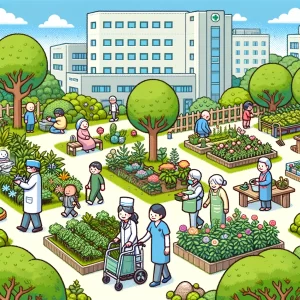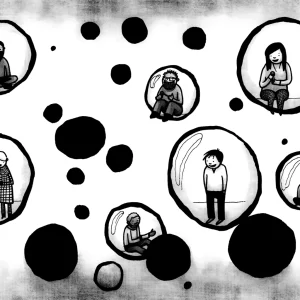
Nature’s Power in the City: How Fair Access to Green and Blue Spaces Transforms Mental Health
In cities bustling with people, skyscrapers, and constant motion, finding moments of peace and connection to nature can feel like a luxury. But recent research highlights how urban green and blue spaces—think parks, gardens, rivers, and lakes—aren’t just aesthetic; they’re powerful tools for boosting public health, especially mental well-being. A study conducted in the Chang-Zhu-Tan urban cluster in Hunan Province, China, sheds new light on how access to these spaces can transform lives. By prioritizing fairness in access, or “Green and Blue Space Justice,” cities can ensure everyone benefits from these pockets of nature, regardless of their background or neighborhood.
Let’s explore what this study reveals about how green and blue spaces contribute to mental health and what cities worldwide can learn from these findings.
Green Space Justice: Why It Matters for Mental Health
“Green Space Justice” is a concept rooted in environmental justice. It emphasizes equal access to parks, green spaces, and natural environments for everyone in a city. For many, access to these areas is linked to better mental health and a higher quality of life. However, green spaces are often more abundant in affluent neighborhoods, leaving disadvantaged communities with fewer opportunities to enjoy nature’s benefits.
In Chang-Zhu-Tan, researchers set out to understand the connection between accessible green spaces and mental well-being. They found that equitable access to green spaces positively impacted residents’ psychological responses (like joy and relaxation), physical activity, and overall mental health. Residents near green spaces were more likely to feel relaxed and satisfied, engage in outdoor activities, and report better mental health. This connection, especially for communities historically underserved in terms of public resources, suggests a vital area for urban improvement: equitable green space distribution.
Psychological and Physical Benefits: The Power of Green Spaces
Green spaces aren’t just visually calming; they play a profound role in mental health. When people engage with nature, they experience a psychological boost, marked by lower stress and improved moods. This study highlights a chain of benefits—when people feel more psychologically uplifted in green spaces, they are also more likely to engage in physical activities, whether that’s a walk in the park, a jog along a tree-lined path, or a simple rest on a bench.
Physical activity, in turn, brings further mental health benefits. Movement in green spaces—like a stroll through a garden or a quick exercise session—has been shown to reduce feelings of anxiety and depression. Together, these psychological responses and physical activities create a “chain effect,” leading to an overall improvement in mental health. The more accessible green spaces are, the more they foster mental health resilience for city residents.
Blue Spaces: Nature’s Soothing Counterpart to Green Spaces
While green spaces get much attention, the study also emphasizes the importance of “Blue Space Justice.” Blue spaces—lakes, rivers, and ponds—provide unique, soothing benefits that complement green spaces. The proximity to water, even just visually, can calm the mind, helping to lower stress levels and even reduce symptoms of depression. This study found that while blue spaces may not have a direct impact on mental health as strongly as green spaces, they significantly enhance the positive effects of green spaces.
For example, individuals living near both a park and a water body showed higher levels of psychological relief and increased physical activity, like running or cycling, than those near green spaces alone. This synergy between green and blue spaces offers a holistic approach to urban planning, one that maximizes nature’s potential to improve public health.
Policy Takeaways for Healthier Cities
The findings from this study carry powerful implications for city planning and public policy. Suppose cities prioritize the fair distribution of green and blue spaces. In that case, they can create environments that support mental well-being for all residents, reducing health disparities and building resilience in underserved communities. Here are a few actionable takeaways:
1. Equal Access to Green Spaces
Cities should strive for an equal distribution of parks and green areas across neighborhoods, ensuring that everyone—regardless of income level or background—has nearby access to green spaces.
2. Integrate Blue Space Resources
Incorporating rivers, ponds, and lakes into urban planning enhances the mental health benefits provided by green spaces. Cities near natural bodies of water can consider pedestrian paths and benches along these areas, creating accessible zones for relaxation and physical activity.
3. Community-Centric Design
Engaging communities in the planning and design of green and blue spaces can ensure these areas meet residents’ needs. Creating spaces that reflect community preferences, such as play areas for children, fitness trails, or quiet zones for relaxation, can make a real difference in usage and impact.
4. Technology in Urban Planning
Utilizing data and technology like Geographic Information Systems (GIS) can help city planners visualize green and blue space distribution and identify gaps in accessibility, ensuring underserved communities are prioritized in future projects.
Challenges to Implementation: Bridging the Gap
While the advantages of green and blue spaces are clear, achieving fair access in dense urban areas isn’t without obstacles. Resource allocation is complex and often uneven, with parks more common in higher-income neighborhoods. Moreover, transportation networks impact accessibility, as some residents might live near a green or blue space but face barriers in reaching them due to poor public transit. Lastly, while public participation is invaluable, cities need efficient mechanisms to capture and act on community feedback to make green and blue spaces truly inclusive.
Join the Conversation
We’d love to hear your thoughts!
- How has access to green or blue spaces impacted your mental well-being?
- What changes would you like to see in your city’s parks or green areas to make them more accessible and beneficial?
Your experiences and perspectives can add depth to this discussion and inspire future urban planning efforts.
Join the Community – Get Your Weekly Public Health Update!
Be a health leader! Subscribe for free and share this blog to shape the future of public health together. If you liked this blog, please share it! Your referrals help This Week in Public Health reach new readers.



